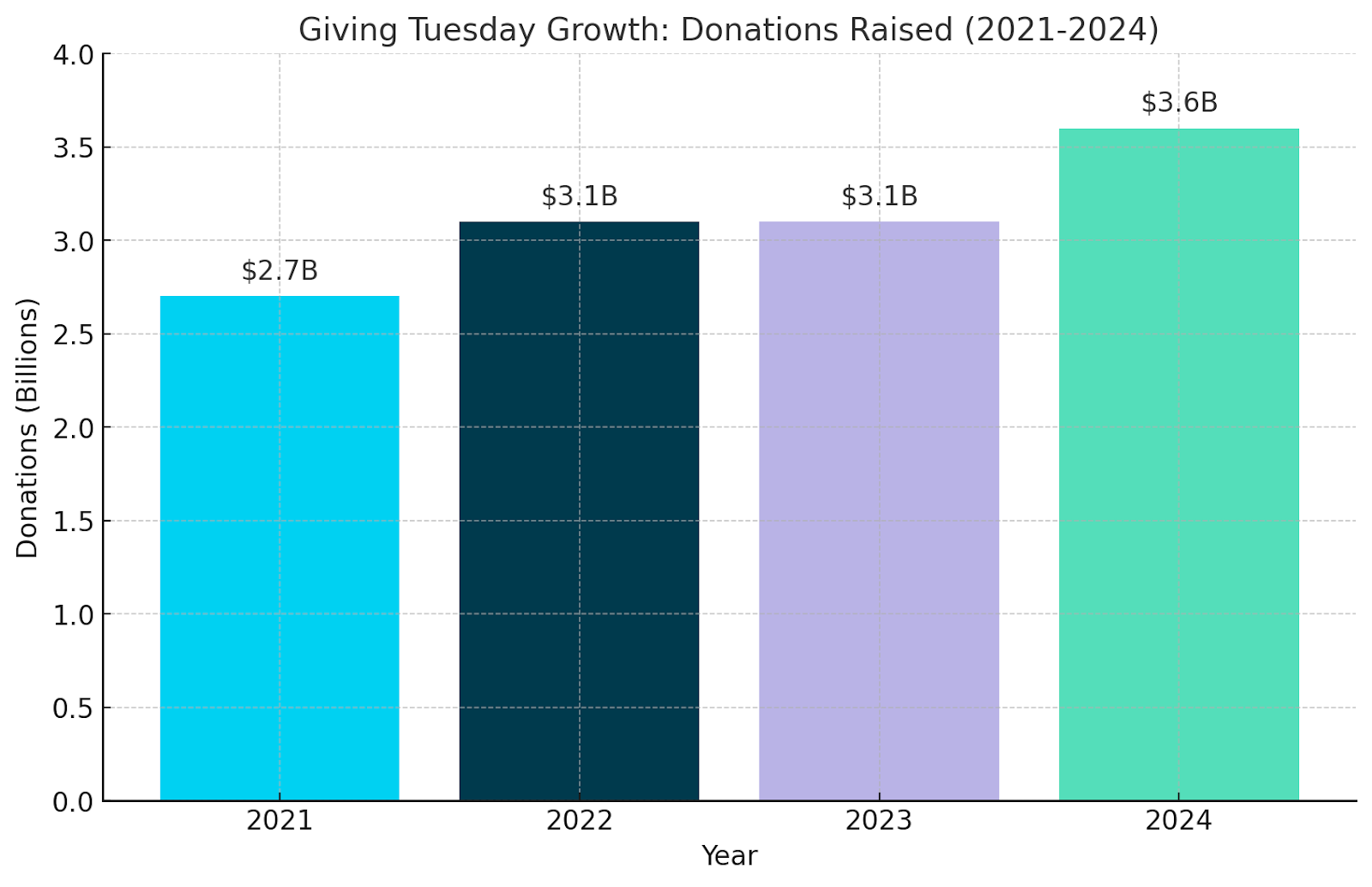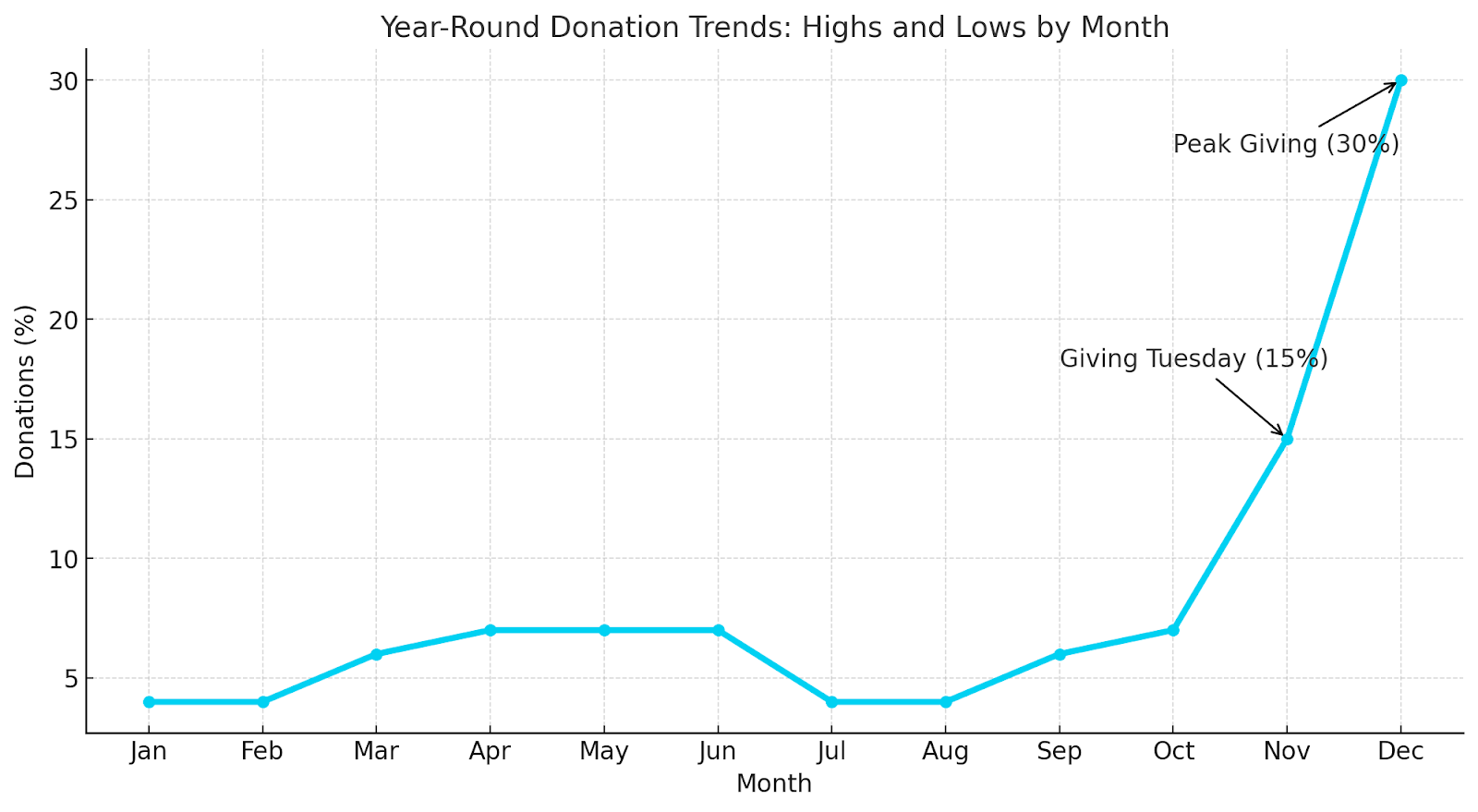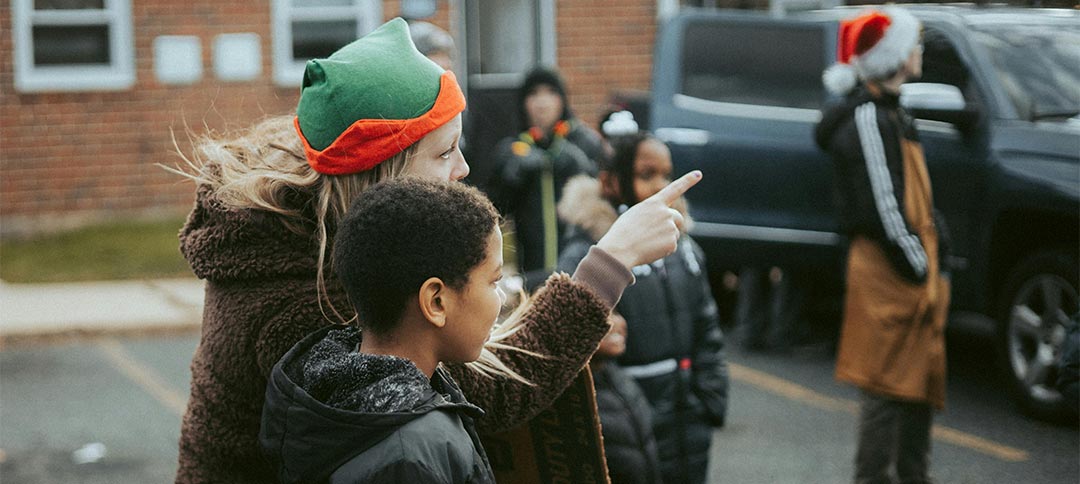If you run a nonprofit, you already know December is a big deal for fundraising. But have you ever wondered exactly how big it really is, or why giving explodes at the end of each year?
Turns out, year-end giving is more than just a helpful boost, it’s the lifeline for nonprofits of all sizes. In fact, recent year-end giving statistics show that nearly a third of all charitable donations happen in December alone. Even more eye-opening, roughly 5% of all annual giving occurs on December 31st, the very last day of the year.
What’s driving this rush? Is it tax incentives, holiday generosity, or perhaps a little of both? And how does Giving Tuesday fit into all this?
In this study, we'll unpack these seasonal fundraising trends with clear data, real-world insights, and practical advice. You'll get a closer look at why donors give when they do, and how your nonprofit can leverage these patterns to boost fundraising year-round.
Year-end giving by the numbers
December isn’t just busy, it’s critical. Here’s why:
- 30% of all annual giving happens in December. Yep, nearly one-third of your annual fundraising could happen in one month. Online giving alone can account for between 17% and 34% of your entire year's digital revenue.
- Last-minute giving is real. About 10% of all donations arrive in the last three days of December. Many donors procrastinate, but December 31st itself often represents a full 5% of yearly donations.
Why is this happening? A couple of reasons:
- Tax incentives: Donors love those end-of-year tax deductions. Charitable donations are deductible through December 31st, motivating last-minute generosity.
- Holiday spirit: People are naturally inclined to give during the holidays, driven by generosity, gratitude, and the desire to make an impact.

Knowing these seasonal fundraising trends helps you prepare stronger end-of-year campaigns, ensuring you capture every possible dollar in this pivotal period.
The Giving Tuesday effect: Launching your year-end campaign
Giving Tuesday, the global generosity movement on the Tuesday after Thanksgiving, has quickly become a cornerstone event for nonprofits. Here's a snapshot of recent Giving Tuesday data:
- $3.6 billion raised in 2024, up from $3.1 billion in 2023. The growth trajectory has been consistently strong since the movement began in 2012.
- 36.1 million Americans participated in Giving Tuesday 2024, making it the largest single-day donor acquisition event of the year.

Giving Tuesday not only jumpstarts year-end giving, it sets the momentum for the entire holiday giving season. Nonprofits that effectively leverage this day typically maintain donor interest and engagement right through December.
Seasonal donation patterns beyond December
Giving isn't just a December phenomenon. It fluctuates predictably across seasons, presenting unique opportunities (and challenges) at different times of the year:
Winter slump (January–March)
Donations usually dip sharply right after December. January and February are typically among the slowest months, each averaging just 3–5% of yearly donations.
Spring stabilization (April–June)
Spring sees modest recovery. Special events and awareness campaigns (think Earth Day or school fundraisers) help stabilize giving, though no spring month comes close to matching December’s volume.
Summer slowdown (July–August)
July and August represent a significant fundraising lull, often called the "summer slump," when donations can drop nearly 18% below monthly averages. Nonprofits usually use this period to engage donors without heavy fundraising pressure.
Fall ramp-up (September–November)
Fundraising picks up in fall, building steadily from September onwards. Giving Tuesday at the end of November marks the official start of the year-end fundraising rush. November alone often brings in around 15% of the year's online donations.

Post-COVID shifts in donation behavior
Since COVID-19, the fundraising landscape has shifted notably, although the core seasonal trends remain strong:
- Giving spikes & plateaus: After initial surges in giving during the pandemic, 2022 and 2023 saw some flattening of growth. Donations began increasing again significantly by late 2024.
- Fewer donors, larger gifts: Today, fewer Americans give, but those who do are giving more. Nonprofits increasingly rely on larger donations from fewer individuals, highlighting the importance of maintaining donor relationships.
The rise of digital giving: Post-pandemic, online giving jumped from 8% to about 12% of total donations, reflecting a permanent shift towards digital platforms. December remains crucial, with online giving accounting for over a quarter of annual digital revenue.
How nonprofits can adapt to these seasonal trends
Understanding these seasonal fundraising trends is great, but knowing how to apply that understanding practically is even better. Here are three straightforward strategies your nonprofit can use right away:
1. Launch early & communicate clearly
Your year-end campaign should kick off well before December. Ideally, you’ll begin planting the seeds in October or early November, giving donors plenty of time to budget and plan their donations.
Quick tip:
Don’t be shy, clearly communicate the urgency, purpose, and impact of donations. Make it easy for donors to see how their gift matters, using simple language and clear storytelling.
2. Maximize Giving Tuesday
Use Giving Tuesday as a campaign launchpad rather than a standalone event. Why? Because nonprofits that build momentum starting on Giving Tuesday typically see higher overall year-end totals.
Quick tip:
Match Giving Tuesday donations with a special incentive, like a matching gift from a sponsor or a recognition event, to motivate donors. Then immediately follow up with targeted communications to keep donors engaged through December.
3. Leverage digital giving & monthly donors
Donors today prefer convenience. Investing in seamless online donation tools and offering recurring (monthly) giving options can significantly boost your donations. Monthly donors also help smooth out seasonal fluctuations, providing steady support during slower periods.
Quick tip:
Clearly showcase the option for monthly giving in every digital appeal, emphasizing the lasting impact of regular, smaller donations.
Common mistakes nonprofits make during the giving season
Even experienced fundraisers can fall into traps during the hectic year-end season. Here's how to dodge some common pitfalls:
Mistake #1: Waiting too long to start your campaign
If your December appeal arrives mid-month, you’ve missed crucial weeks of potential giving. Donors have likely already allocated their charitable budgets elsewhere.
Solution:
Start earlier, ideally around Giving Tuesday or even before. Keep your nonprofit visible and top-of-mind throughout the holiday season.
Mistake #2: Neglecting follow-up
A donor who gives once is a great candidate to give again. Too many nonprofits forget to follow up after the initial gift, losing valuable momentum.
Solution:
Plan a follow-up sequence thanking donors, updating them on progress, and inviting additional engagement. It can boost donor retention significantly.
Mistake #3: Complicating the donation process
Nothing kills donations faster than friction. If your donation process is cumbersome, confusing, or overly complicated, donors will abandon it.
Solution:
Simplify your donation page. Reduce the number of fields and make sure the process is mobile-friendly and intuitive.
Looking ahead: The future of year-end giving & seasonal patterns
What should nonprofits expect in the coming years?
- Continued emphasis on digital: Online and mobile giving will keep growing. Nonprofits that embrace digital will thrive; those who hesitate risk falling behind.
- More sophisticated donor targeting: Expect greater personalization and data-driven outreach. Nonprofits that segment audiences and tailor messaging will see better response rates and higher average gifts.
- Rising importance of recurring donors: Monthly giving programs will increasingly form the backbone of stable nonprofit revenue, offsetting seasonal volatility.
In short, adapting to these evolving trends means your nonprofit won’t just survive, it’ll thrive, no matter the season.
Final takeaways: Seasonal fundraising simplified
Let’s quickly recap the most important insights:
- December is your best opportunity, don’t waste it.
- Leverage Giving Tuesday strategically as a springboard.
- Engage donors year-round to minimize slowdowns.
- Prioritize simplicity and convenience for donors, especially online.
- Invest in monthly giving for long-term stability.
Your donors want to help; your job is simply making it easier, clearer, and more compelling for them to do so. Use these insights, and your year-end giving strategy can become a consistent powerhouse.
Ready to take action?
Harnessing these seasonal donation patterns can significantly increase your nonprofit’s fundraising potential. With the right strategies in place, your nonprofit can confidently navigate seasonal shifts and make every giving season count.





